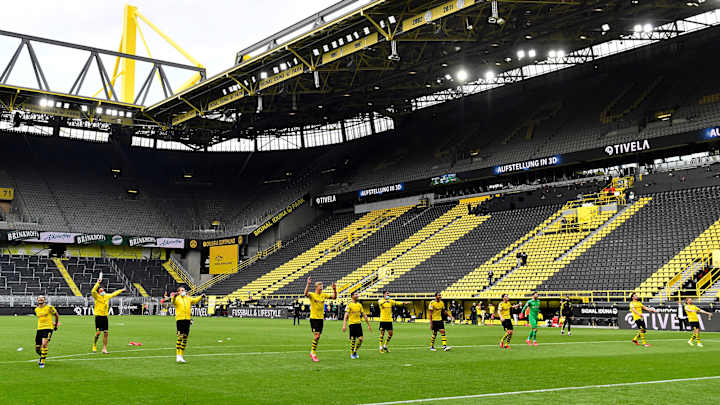Bundesliga's Return Brings Unique Quirks, Reprieve for Players and Viewers

At 3:32 p.m., local time, referee Deniz Aytekin blew his whistle. Erling Braut Haaland took the opening kick, and the biggest game on the first weekend of the Bundesliga’s resumption, Borussia Dortmund against Schalke, was underway–two minutes later than scheduled for no other reason, it seemed, than that Aytekin and his assistants were slightly delayed in taking the field.
Football was back, not quite as we’ve come to know it, but back nonetheless. The players emerged from the tunnel socially distanced, in keeping with new protocols brought on by the coronavirus pandemic. The masked substitutes took their places on widely spaced-out seats stretching along the front of one stand. And the stands, of course, were empty. The most obvious impact of that, at least watching on television, was the change to the ambient noise, echoing shouts, the whistle and the disconcertingly loud sound of the ball being kicked, replacing the usual backdrop of chants and roars and groans.
Dortmund began slowly, and it was tempting to think that it was suffering from the lack of atmosphere. But perhaps that was an illusion–a thought that would recur in varying forms throughout: when we watch a game, to what extent are we conditioned by crowd reaction? Dortmund, after all, had been forced into a late change shortly before kickoff as U.S. international Giovanni Reyna was injured in the warmup and had to be replaced by Thorgan Hazard. With Julian Brandt consequently forced deeper, was it a case simply of Dortmund taking a little time to settle to the rejigged shape?
Teams often start slowly, anyway. They do play patiently in the opening minutes, feeling out their opponents, it’s just that we don’t notice it, because, particularly in a derby, there is so much else going on. There were various suggestions on social media that the players were not fully match-fit, that they were subconsciously eschewing physical contact and that the training-ground vibe was making them more mannered in their approach. Perhaps all of that was true. Perhaps crowds do have a significant base-level impact in a game, investing it with meaning, encouraging greater aggression. Or perhaps it just seems that way. In that sense, football in these conditions might be a little like when Lars von Trier stopped using background music in films, bring the focus onto the actors in the drama without external emotional manipulation.
The mind, anyway, soon adjusted and began to notice the usual things: Dortmund’s increasing fluency, Brandt’s capacity to find space, Markus Schubert’s struggles with the ball at his feet. And there could be nothing more normal than the identity of the first goalscorer of the Bundesliga’s restart: Haaland, scoring his 10th goal in nine league games since joining Dortmund in January. It was a goal of real quality as well, with the Norwegian opening his foot to guide in Hazard’s cross after he had been released by Brandt’s flick. The celebration–three players standing in a responsibly large triangle and dancing awkwardly–was perhaps a little odd, brought on by the new coronavirus-prevention protocols, but the goal was beautiful whatever the backdrop.
With the second, driven in just before halftime by Raphael Guerreiro, came confirmation of a surprising bonus of the lack of crowd noise: the “ching” a shot makes when hitting the metal support for the net at the back of the goal. Haaland had managed, despite a full crowd, to generate a similar noise with his ferocious strike against Paris Saint-Germain in the Champions League earlier this year. It may now become a regular–if hopefully temporary–delight. And once you’ve gotten used to it, there’s something beguiling even about the sound of a clean side-foot pass.
Cricket fans, thanks to largely empty grounds for county games and to microphones set in the stumps at international matches, are used to rhapsodizing about the sound of a shot, from the rifle-crack of a well-hit cut to the dull thud of a soft-handed backward defensive to the crisp “tock” of a cover drive; football, perhaps, will gain a similar aural appreciation.
But that is all minor detail, as are the first results from the day the Bundesliga returned: Dortmund hammering Schalke, 4-0; RB Leipzig dominating but failing to beat Freiburg, which had a last-minute winner ruled out by a tight VAR offside call in a 1-1 draw; Hertha Berlin winning with surprising ease, 3-0 at Hoffenheim; Wolfsburg edging Augsburg in stoppage time; Fortuna Dusseldorf and Paderborn playing to a scoreless draw in a relegation battle. Far more important is that football is being played again, period. Only in the next couple of weeks will it become apparent whether this is working, whether football, with all of the new protocols, is actually safe. But psychologically and symbolically, this was a huge moment. There is now a model for the rest of Europe to follow. As a spectacle, it might not be perfect, but it is what we have.
With or without fans, football is football.

An accomplished author of multiple books, Jonathan Wilson is one of the world’s preeminent minds on soccer tactics and history.